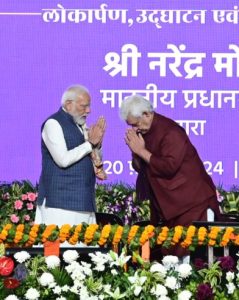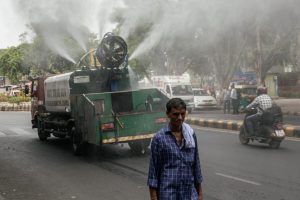India well-placed to avoid stagflation; ‘2020 fiscal package stabilised economy’

File photo credit Twitter Nirmala Sitharaman
By Nancy Sharma and Pratik Gudhate
New Delhi, July 27: Global economy remains on the edge amid supply chain disruptions, while shadow of recession looms over several countries .
After the Covid-19 pandemic, supply shocks arose with the disruption in supply chains. Simultaneously, the aggregate demand for goods also increased, while the aggregated demand for services remained stagnant.
The recovery period of 2020-2021 reflected that the supply chain bottlenecks have been countered. However, it was found to be misleading[i].
The imbalance in excess demand and supply chain bottlenecks spiked the inflation rates. On top of that, the Ukraine-Russia war added fuel to the already raging fire.
Since the European countries are more open in terms of foreign trade, the spill over of the war caused food and fuel price shocks, leaving many countries with high headline inflationary pressures.
The recent Bloomberg survey of Economists estimated the recession probability forecasts of the Asian economies such as Sri Lanka, China, Japan, Hong Kong, Pakistan, etc., indicating that they would fall into recession in 2023.[ii]
Sri Lanka serves as a living example for other developing countries and take corrective measures, while the United States and European economies are not isolated from an all-time rise in inflation.
Meanwhile, the probability of slipping into recession for India stands at zero[iii] as the government has undertaken various policy measures to help the Indian economy on path of recovery.

Even when the advanced economies have become economically weaker, India is emerging as an attractive and preferred investment destination.
India received the highest annual Foreign Direct Investment (FDI) inflows of USD 83.57 billion in FY2021-22. The FDI equity inflows in manufacturing also rose by a record 76 per cent in 2021-22.[iv] As a result, the Gross Domestic Product (GDP) of India in FY2021-22 surpassed its pre-pandemic (FY2019-20) level by 1.5 per cent.
The unemployment rate also dropped in May 2022 in both urban and rural areas.[v] The Goods and Services Tax (GST) collection in June 2022 stood at Rs 1.4 lakh crores, reflecting a gathering pace of business activities.[vi]
The reason behind India’s resilient performance against the shocks can be attributed to the policy interventions both at monetary and fiscal level.
After the pandemic shock, future expectations of the households transitioned into precautionary savings and when the economy recovered, consumer spending increased at a rapid pace, bringing higher liquidity in the economy.
It is noteworthy that price instability leads to a reduction in the investment rate, wages and savings.
The savings are likely to be invested into liquid assets like gold, which further leads to an outflow of capital as 98 per cent of gold demand is met with imports.
To curb this scenario, the Reserve Bank of India (RBI) has come up with tightened monetary policy interventions to anchor headline inflation (food and fuel price rise) and ease it into core inflation by hiking the prices of other commodities keeping into consideration the long-term economic growth of India.
The Central government had announced a special economic and comprehensive relief package with an outlay of Rs 20 lakh crores in March 2020, constituting 10 per cent of the GDP to combat the impact of the Covid-19 pandemic and gave more emphasis on becoming a self-reliant economy.
The components of this package included a provision of Rs 3 lakh crores for collateral-free automatic loans for businesses, including Micro, Small, and Medium Enterprises (MSMEs), Pradhan Mantri Garib Kalyan Anna Yojana (PM-GKAY) under which free ration is provided to 80 crore people. Moreover, a sum of Rs 500 was directly transferred to the women Jan Dhan account holders on a monthly basis.
The fiscal package helped the Indian economy maintain a stable growth rate.
In the GDP growth projections for December 2021, the estimate for the Indian economy stood high at 8.7 per cent as compared to the other advanced economies, which witnessed contractions.[vii]
Moreover, with the effect of in-kind food subsidies on poverty and inequality, it is estimated by the International Monetary Fund’s (IMF) working paper on Pandemic, Poverty, and Inequality – Evidence from India, highlighted that for the first time, extreme poverty which stood at 31.9 per cent in 2004 declined to a record 0.9 per cent in 2020. Also, despite the pandemic, the rate of extreme poverty only rose by 0.1 per cent from 0.8 per cent in 2019.[viii]
This demonstrates resilience of the Indian economy amid multiple shocks and the innate strength of macro fundamentals, underlining strength to avoid risks of potential stagflation.I
Walking on the footprint of Sabka Saath, Sabka Vikas, Sabka Vishwas, Sabka Prayaas, the government has supported and empowered every stratum of society.
(Views expressed in the article belong solely to authors, who are Research Fellows at Public Policy Research Centre)
REFERENCES
[i] https://www.ecb.europa.eu/pub/conferences/ecbforum/shared/pdf/2022/Kalemli-Ozcan.pdf
[ii] https://economictimes.indiatimes.com/news/economy/indicators/india-has-zero-probability-of-slipping-into-recession-says-survey/articleshow/93120581.cms
[iii] https://economictimes.indiatimes.com/news/economy/indicators/india-has-zero-probability-of-slipping-into-recession-says-survey/articleshow/93120581.cms
[iv] https://pib.gov.in/PressReleasePage.aspx?PRID=1826946
[v] https://rbidocs.rbi.org.in/rdocs/Bulletin/PDFs/1STATEOFTHEECONOMY53E4388A1B544BE59B7F1D3306FD830E.PDF
[vi] https://pib.gov.in/PressReleasePage.aspx?PRID=1838523
[vii] https://rbidocs.rbi.org.in/rdocs/Bulletin/PDFs/1STATEOFTHEECONOMY53E4388A1B544BE59B7F1D3306FD830E.PDF
[viii] https://www.imf.org/en/Publications/WP/Issues/2022/04/05/Pandemic-Poverty-and-Inequality-Evidence-from-India-516155







